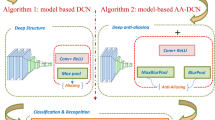Abstract
Emotion recognition is a hot research area in deep learning and computer vision that analyses expressions from both static and dynamic sequences of facial expressions to reveal human emotional states. In recent decades, deep learning approaches have been exhibiting a superior performance on image representation datasets. However, the convolutional neural network (CNN) requires a larger number of labeled datasets for training and accurate classification results. It is always inevitable, whereas unsupervised representation learning models like autoencoder do not require labeled information for training. Meanwhile, it is difficult to infer the feature map when the size of the CNN layer is increased. To address these challenges, this paper introduced a self-supervised deep learning technique called convolutional sparse autoencoder (CSA) which can learn robust features from small data with unlabeled facial expression datasets. Moreover, sparsity is added in the max pooling layer for the feature map which makes the backpropagation optimizer Adam work efficiently for the CSA training; thus, no complicated optimizer is not involved. Finally, the trained convolutional sparse encoder part is combined with the softmax layer for emotion classification. The performance results demonstrate that the proposed approach achieved 98% of accuracy on the CK+ dataset and outperforms various state-of-the-art methods.
Access this chapter
Tax calculation will be finalised at checkout
Purchases are for personal use only
Similar content being viewed by others
References
Kołakowska, A., Landowska, A., Szwoch, M., Szwoch, W., Wróbel, M.R.: Emotion recognition and its applications. In: Hippe, Z., Kulikowski, J., Mroczek, T., Wtorek, J. (eds.) Human-Computer Systems Interaction: Backgrounds and Applications 3. AISC, vol. 300, pp. 51–62. Springer, Cham (2014). https://doi.org/10.1007/978-3-319-08491-6_5
Zhang, Y.: A better autoencoder for image: convolutional autoencoder. In: ICONIP17-DCEC (2018). http://users.cecs.anu.edu.au/Tom.Gedeon/conf/ABCs2018/paper/ABCs2018_paper_58.pdf
Bank, D., Koenigstein, N., Giryes, R.: Autoencoders. arXiv preprint arXiv:2003.05991 (2020)
Zhao, X., Shi, X., Zhang, S.: Facial expression recognition via deep learning. IETE Tech. Rev. 32(5), 347–355 (2015)
Mollahosseini, A., Chan, D., Mahoor, M.H.: Going deeper in facial expression recognition using deep neural networks. In: 2016 IEEE Winter Conference on Applications of Computer Vision (WACV), pp. 1–10. IEEE (2016)
Jaiswal, A., Raju, A.K., Deb, S.: Facial emotion detection using deep learning. In: 2020 International Conference for Emerging Technology (INCET), pp. 1–5. IEEE (2020)
Minaee, S., Minaei, M., Abdolrashidi, A.: Deep emotion: facial expression recognition using the attentional convolutional network. Sensors 21(9), 3046 (2021)
Akhand, M.A.H., Roy, S., Siddique, N., Kamal, M.A.S., Shimamura, T.: Facial emotion recognition using transfer learning in the deep CNN. Electronics 10(9), 1036(2021)
Viola, P., Jones, M.J.: Robust real-time face detection. Int. J. Comput. Vis. 57(2), 137–154 (2004)
Kavukcuoglu, K., Sermanet, P., Boureau, Y.L., Gregor, K., Mathieu, M., Cun, Y.: Learning convolutional feature hierarchies for visual recognition. In: Advances in Neural Information Processing Systems, vol. 23 (2010)
Bristow, H., Eriksson, A., Lucey, S.: Fast convolutional sparse coding. In: Proceedings of the IEEE Conference on Computer Vision and Pattern Recognition, pp. 391–398 (2013)
Rigamonti, R., et al.: On the relevance of sparsity for image classification. Comput. Vis. Image Underst. 125, 115–127 (2014)
Zeiler, M.D., Fergus, R.: Visualizing and understanding convolutional networks. In: Fleet, D., Pajdla, T., Schiele, B., Tuytelaars, T. (eds.) ECCV 2014. LNCS, vol. 8689, pp. 818–833. Springer, Cham (2014). https://doi.org/10.1007/978-3-319-10590-1_53
Zeng, N., Zhang, H., Song, B., Liu, W., Li, Y., Dobaie, A.M.: Facial expression recognition via learning deep sparse autoencoders. Neurocomputing 273, 643–649 (2018)
Liu, Y., Hou, X., Chen, J., Yang, C., Su, G., Dou, W.: Facial expression recognition and generation using sparse autoencoder. In: 2014 International Conference on Smart Computing, pp. 125–130 (2014). IEEE
Usman, M., Latif, S., Qadir, J.: Using deep autoencoders for facial expression recognition. In: 2017 13th International Conference on Emerging Technologies (ICET), pp. 1–6 (2017). IEEE
Lv, Y., Feng, Z., Xu, C.: Facial expression recognition via deep learning. In: 2014 International Conference on Smart Computing, pp. 303–308 (2014). IEEE
Masci, J., Meier, U., Cireşan, D., Schmidhuber, J.: Stacked convolutional auto-encoders for hierarchical feature extraction. In: Honkela, T., Duch, W., Girolami, M., Kaski, S. (eds.) ICANN 2011. ICANN 2011. LNCS, vol. 6791, pp. 52–59. Springer, Heidelberg (2011). https://doi.org/10.1007/978-3-642-21735-7_7
Boughida, A., Kouahla, M.N., Lafifi, Y.: A novel approach for facial expression recognition based on Gabor filters and genetic algorithm. Evol. Syst. 13(2), 331–345 (2021)
Uddin, M.Z., Lee, J.J., Kim, T.S.: An enhanced independent component-based human facial expression recognition from video. IEEE Trans. Consum. Electron. 55(4), 2216–2224 (2009)
Zhang, L., Tjondronegoro, D.: Facial expression recognition using facial movement features. IEEE Trans. Affect. Comput. 2(4), 219–229 (2011)
Happy, S.L., Routray, A.: Automatic facial expression recognition using features of salient facial patches. IEEE Trans. Affect. Comput. 6(1), 1–12 (2014)
Mishra, S., Joshi, B., Paudyal, R., Chaulagain, D., Shakya, S.: Deep residual learning for facial emotion recognition. In: Shakya, S., Bestak, R., Palanisamy, R., Kamel, K.A. (eds.) Mobile Computing and Sustainable Informatics. LNDECT, vol. 68, pp. 301–313. Springer, Singapore (2022). https://doi.org/10.1007/978-981-16-1866-6_22
Yang, S., Kim, Y., Kim, Y., Kim, C.: Combinational class activation maps for weakly supervised object localization. In: Proceedings of the IEEE/CVF Winter Conference on Applications of Computer Vision, pp. 2941–2949 (2020)
The Extended Cohn-Kanada Database. https://www.ri.cmu.edu/. Accessed 15 Nov 2022
Acknowledgment
The authors wish to express their sincere thanks to the Centre for Machine Learning and Intelligence (CMLI) for providing resources to conduct this research study. This centre is sponsored and supported by the Department of Science and Technology (DST)-CURIE, India.
Author information
Authors and Affiliations
Corresponding author
Editor information
Editors and Affiliations
Rights and permissions
Copyright information
© 2023 The Author(s), under exclusive license to Springer Nature Switzerland AG
About this paper
Cite this paper
Mohana, M., Subashini, P. (2023). Convolutional Sparse Autoencoder for Emotion Recognition. In: Hassanien, A.E., et al. The 3rd International Conference on Artificial Intelligence and Computer Vision (AICV2023), March 5–7, 2023. AICV 2023. Lecture Notes on Data Engineering and Communications Technologies, vol 164. Springer, Cham. https://doi.org/10.1007/978-3-031-27762-7_1
Download citation
DOI: https://doi.org/10.1007/978-3-031-27762-7_1
Published:
Publisher Name: Springer, Cham
Print ISBN: 978-3-031-27761-0
Online ISBN: 978-3-031-27762-7
eBook Packages: Intelligent Technologies and RoboticsIntelligent Technologies and Robotics (R0)




